| |
 |
|
The Smoky Mountains are like an old man, dark and brooding, shoulders rounded from the weight of years and a bit grumpy. In fact, the rounded peaks are among the oldest mountains in the world. And, like an old man, these mountains were here before the dinosaurs.
At the highest elevations the wind is often fierce with more than 85 inches of precipitation falling a year, more than anywhere else in the United States outside the Pacific Northwest and parts of Alaska. In fact, climbing from the warm and sunny base at 800 feet to the 6,600 foot ridgeline mimics the latitudinal changes found by traveling from Tennessee all the way to Canada. This range of climates creates many different environments, from wet lands to hardwood to spruce forests. |
|
| |
Spruce Falls |
|
Photos courtesy Great Smokey Mountains National Park |
|
| |
|
|
|
|
| |
To experience these lush mountains in their pristine state, visit Great Smoky Mountains National Park. The Park lies half in southeastern Tennessee and half in western North Carolina for a total 814 sq. miles or 500,000 acres, one of the largest protected areas in the Eastern U.S. The Appalachian Trail (AT) bisects the Park for 73 miles, following the ridge that divides the two states for the highest, toughest, and some say the most beautiful, elevations on the trail’s entire 2,175 mile length. It is the most visited park in the U.S., within a day’s drive of two-thirds of the country’s population. Unlike other national parks, it is a no-fee park. But that should not discourage those who want a wilderness experience.
“Most of the several thousand visitors a day who come here,” said the Ranger at Sugarlands Visitor Center near Gatlinburg, TN, “are what we call ‘windshield visitors’. They never get out of their cars except to maybe come to the Visitors Center.” |
|
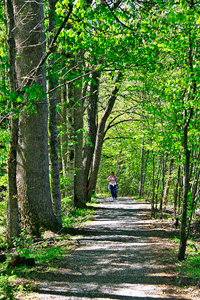
|
|
| |
|
|
SMNP trail |
|
| |
|
|
|
|
| |
Because of weather, terrain and development possibilities, the Tennessee side is by far the most visited. However, like many places, it doesn’t take long to walk, bike, kayak or even drive beyond where most people venture. With the choice of 800 miles of maintained hiking trails, 550 miles of designated horse trails and many miles of streams you will quickly find yourself alone to enjoy the solitude. Overnight backcountry camping permits are required but at no charge. This system is designed to allow people to love this wild place without loving it to death.
Depending on who you come with (if anyone at all), there’s a choice of your favorite outdoor activities or a honky tonk experience -- backpack to meet that grumpy old Smoky Mountains man or ride the Thunderland twister at Dollywood. |
|
| |
|
|
| |
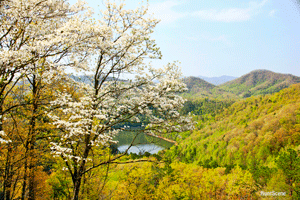 |
|
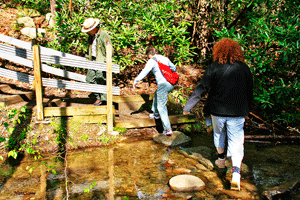 |
|
| |
Smokey Mountains dogwoods and lake |
|
Smokey Mountains ranger-led hike |
|
| |
|
|
|
|
| |
I wanted to walk among what is left of the primal Old Growth Forest that still makes up 37 percent of the Park. Due to intense logging in the 19th and early 20th centuries, it can be difficult to access the Old Growth. In fact, over-logging is what led to the designation of the only national park created from private land. What visitors see now is vegetation that is only 80 years old – growing since the park’s authorization in 1926 (it was officially dedicated by FDR in 1940).
Because of time constraints, I hiked one of the most popular and accessible trails in the Park, Laurel Falls Trail. But I kept going beyond Laurel Falls – one of at least a gazillion waterfalls in the park -- and the hiking population totally dropped off. It was mid-week in April, so the summer crowds had not yet arrived. The temperatures were cool with dogwood, tulip and redbud trees blooming their hearts out. The first mile to the waterfall was actually paved. I could see through the trees to the valleys below due to the fact the hardwoods were just leafing out and, more seriously, the Bark Beetle infestation of the pine trees. |
|
| |
|
|
| |
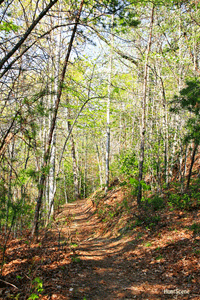 |
|
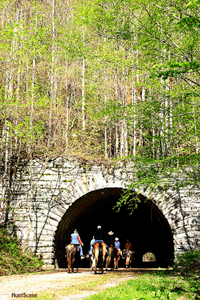 |
|
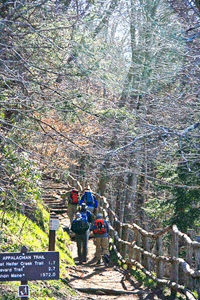 |
|
| |
SMNP typical trail |
|
SMNP Road to Nowhere |
|
Newfound Gap summit |
|
| |
|
|
|
|
|
|
| |
Once past the falls and the picnickers, the trail turned rough and steep, curved around a ridge and doubled back above Laurel Falls. Three other streams joined Laurel Creek at the point I entered an area of Eastern Hemlock woods and total silence. The trees got bigger the deeper into the woods I walked. This was virgin forest with some humongous trees that could have been saplings when the Spaniards first came ashore. Truth be known, it was a little creepy. This must be Old Man Mountain, being grumpy. Adding to the creepiness was the fact that the Smokies are prime bear habitat, and April is when they wake up from their winter naps.
Laurel Falls Trail joined Cove Mountain Trail which ran along the park boundary and in a few miles brought me to Sugarlands Visitors Center. This section was an example of the major challenge that faces Great Smoky Mountains National Park. On one side of the trail was the pristine forest, on the other were ski chalets, homes, a ski tram and a public hunting area. All this human activity puts tremendous pressure on the park’s infrastructure and resources. |
|
| |
|
|
| |
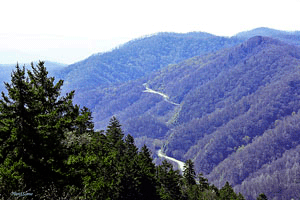 |
|
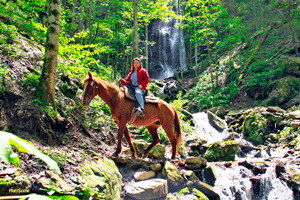 |
|
| |
Newfound Gap Road |
|
Riding to a mountain waterfall |
|
| |
|
|
| |
The name “smoky” comes from the blue mist and low clouds that usually hang over the mountain ridges, like smoke from numerous fires. Unfortunately, today that “smoke” is also air pollution. The Smokies are called the Front Porch of Appalachian culture and history. Originally inhabited by the Cherokee Indians (related to the Algonquin tribes living further north), Scots-Irish settlers took over the land and their descendants still fill the hills and hollers of the Appalachian Mountain chain, running from Maine to northern Alabama. Botanists call the southern Appalachians the seed cradle of the continent – 75 percent of all medicinal plants in the U.S. grow in this area.
The undergrowth is nearly impenetrable in this lush environment, punctuated by tall trees shooting to the sun. Deep caves and treacherous cliffs grab your attention, even walking on maintained trails. Water oozes out of the rocks forming countless little streamlets. I began to understand how Eric Robert Rudolph, the 1996 Atlanta Olympic Park bomber, could hide out in these mountains without being found until 2003. It was just as the Cherokee had done in the 1830s, hiding from the Feds so as not to be rounded up and marched west to Indian Territory. |
|
| |
|
|
|
|
| |
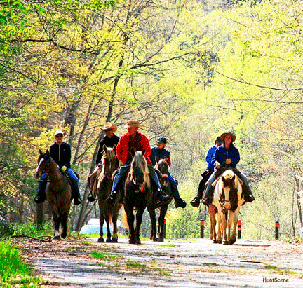 |
|
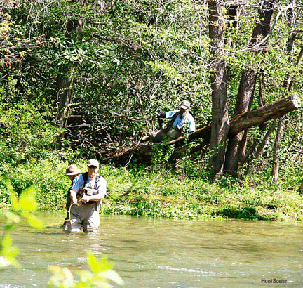 |
|
| |
Smokey Mountains trails |
|
Smokey Mountains trout fishing |
|
| |
|
|
| |
I was picked up near the Visitors Center and driven to Cades Cove for an 11-mile bicycle ride around the Park’s most popular driving and biking loop. Could my legs hold up? Barely, as it turned out.
A group of us rented heavy, clunky mountain bikes from Cades Cove Campground. I know I used all 28 gears on the undulating road that wound through open meadows and deep woods. This lovely valley was a major settlement before the national park was declared, with old churches and cemeteries and a few renovated log houses today giving mute testimony to that harsh, remote life.
The mountains are a mosaic of colors year round. In spring the palette is pastels, with the whites and pinks of dogwoods and Mountain Laurel, the light green of just-leafing trees, the lavender and periwinkle ground cover. Summer is full of deep leafy greens, massive quantities of colorful rhododendron bushes, flame Azalea and late-blooming wildflowers. Autumn is a slap in the face of bold, primary changing colors of 130 different trees. Winter is stark, with bare brown branches and evergreen needles sharpened against the snowy backdrop and low cloud cover. Any time is a good time to make the effort to explore Great Smoky Mountain National Park.
|
|
| |
|
|
| |
GETTING THERE
Information:
Buy a copy of Hiking Trails of the Smokies, a detailed pocket size guide published by the Great Smoky Mountains Association in Gatlinburg, TN. It contains the best narratives of the many available hiking guides.
The Visitors Centers are full of information and the Rangers are walking
encyclopedias about their park.
Accommodations:
If you are with family or a group of people with differing interests, Dollywood Vacation condos in Pigeon Forge, TN provide a great value. This way, you are within driving distance of all the attractions and the National Park. Downtown Gatlinburg has thousands of rooms available, putting you close to that town’s shops and sights as well as to the Park entrance at Sugarlands Visitors Center.
If it’s quiet you want and for those totally into outdoor activities, stay in Townsend, called “the peaceful side of the mountain.” Most accommodations are motels, a few B&Bs or campgrounds with one luxury hotel, the Dancing Bear Lodge & Restaurant. This puts you closest to Cades Cove and some less-traveled hiking trails.
Eating:
There are unusual liquor laws in Tennessee which may contribute to your decision of where you plan to dine. Some towns are dry, some you can buy wine or beer, some you can buy spirits. Family dining with huge portions of southern cooking is most common—be careful, the pounds will quickly attach to your body.
Attractions I didn’t think I’d like and I did:
- The Titanic Exhibit in Pigeon Forge. John Joslyn, one of the divers who explored Titanic’s wreck site, has created two exhibits, one here and one in Branson, MO filled with authentic artifacts from the doomed cruise ship. The self-guided tours are so well done you feel as if you were actually there. Special activities are planned for the 100th anniversary in April 2012. (800-381-7670, 417-334-9500, www.titanicpigeonforge.com)
- Dollywood, for heaven’s sake (particularly Adventure Mountain Challenge Course and the raptor exhibit), and some of the musical productions in Pigeon Forge. Dolly Parton herself is the Grand Marshall at the annual Dolly Parade each May. (865-428-9601, www.dollywood.com)
|
|
| |
|
|
| |
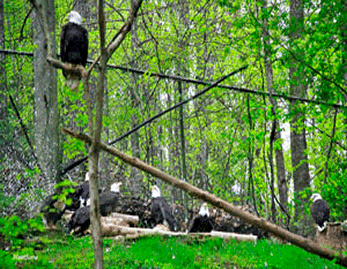 |
|
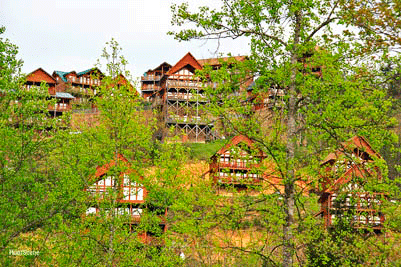 |
|
| |
Council of Elders, Dollywood |
|
Dollywood vacation condos Photos by Diana Hunt |
|
| |
|
|
| |
- The many art galleries in Gatlinburg and shopping outlets in Pigeon Forge.
- Ripley’s (as in Believe it or Not) Aquarium of the Smokies in Gatlinburg features a spectacular shark habitat, Manta-Ray Bay and Penguin Playhouse. (865-430-8808, www.ripleysaquariumofthesmokies.com)
Attractions I knew I would like:
- The 18,000 square foot outdoor retail store in Gatlinburg owned by Nantahala Outdoor Center of North Carolina. (865-277-8209 www.noc.com)
Ober Gatlinburg Amusement Park and Ski Resort. (865-436-5423, www.obergatlinburg.com )
Activities
- Cades Cove Bike Rentals
865-448-9034 www.explorecadescove.com
From May to the end of September, the road is closed to vehicular traffic
Wednesdays and Sundays until 10AM. Otherwise, start pedaling early in the morning to avoid most of the traffic.
One reason I’d like to return:
- Stay for a week at the Great Smoky Mountains Institute at Tremont for a photographic workshop or an environmental hands-on educational program. (865-448-6709 www.gsmit.org)
|
|
|
|
|


